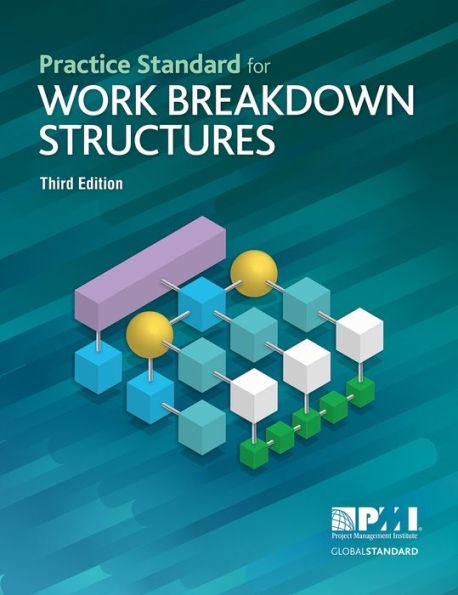Table of Contents
1 Introduction to the Practice Standard for Work Breakdown Structures 1
1.1 Purpose of This Practice Standard 1
1.2 Overview 3
1.2.1 What Is a WBS? 3
1.2.2 Why Is a WBS Required? 3
1.2.3 When Is a WBS Created? When Is a WBS Updated? 4
1.2.4 What Types of Projects Have a WBS? 4
1.3 Purpose of a WBS 5
1.3.1 What Is a WBS Good Practice? 5
1.3.2 Why Is a WBS Essential? 5
1.3.3 Business Value of the WBS 5
1.4 Applicability 6
1.4.1 Relationships among This Practice Standard and Other Project Management Standards 6
1.4.2 Relationships of WBS Processes among Other PMBOK® Guide Processes 8
1.4.3 Placement of the WBS in the Project Life Cycle 8
1.4.4 Program WBS vs. Project WBS 8
1.5 Summary 9
2 Concepts and Principles 11
2.1 Overview 11
2.2 Implementation Using Life Cycles 13
2.2.1 Using WBS in Predictive (Waterfall) Life Cycles 15
2.2.2 Using WBS in Iterative Life Cycles 18
2.2.3 Using WBS in Incremental Life Cycles 20
2.2.4 Using WBS in Agile Life Cycles 23
2.2.5 Key Concepts/Characteristics 28
2.3 Principles 30
2.3.1 The 100 Percent Rule 30
2.3.1.1 More WBS Rules 30
2.3.2 Activities outside the WBS 31
2.3.3 WBS Numbering 31
2.3.3.1 WBS Numbering for Projects 31
2.3.3.2 WBS Numbering for Programs 33
2.4 Methods 33
2.4.1 Decomposition 34
2.4.1.1 Level 1 34
2.4.1.2 Level 2 34
2.4.1.3 Level 3 34
2.4.1.4 Level 4 34
2.4.2 Preparing a WBS 34
2.4.3 Preparation Methods 36
2.4.3.1 Top-Down Approach 37
2.4.3.2 Bottom-Up Approach 37
2.4.3.3 WBS Organizational Standards 38
2.4.3.4 WBS Templates 38
2.4.4 Mind Maps 38
2.4.5 WBS Dictionary 40
2.5 Styles 41
2.5.1 Hierarchical 42
2.5.2 Outline 43
2.5.3 Tabular 47
2.6 Representations of Work 48
2.6.1 Example 1: Build a House 48
2.6.2 Example 2: Organize a Party 49
2.6.3 Example 3: Construct a Custom Bicycle 50
2.7 Summary 51
3 Relationships, Integration, and Context 53
3.1 Overview 53
3.2 Interaction with Other Standards 55
3.2.1 PMI Standards Relationship Diagram 56
3.2.2 The PMBOK® Guide 58
3.2.2.1 Relationship to Process Groups 58
3.2.2.2 Relationship to Inputs, Tools, Techniques, and Outputs 60
3.2.3 Agile Practice Guide 64
3.2.4 Practice Standard for Earned Value Management 65
3.2.5 The Standard for Organizational Project Management (OPM) 65
3.2.6 The Standard for Program Management 65
3.3 Creating the WBS 65
3.3.1 Breaking the Work Down 66
3.3.2 Life Cycles and Types of Decomposition Examples 67
3.3.2.1 Predictive 68
3.3.2.2 Iterative 71
3.3.2.3 Incremental 72
3.3.2.4 Agile 73
3.4 Summary 74
4 WBS Quality 75
4.1 Overview 75
4.2 Using the Quality Guidelines 75
4.2.1 Core Attributes of a Quality WBS 76
4.2.2 Tailoring Method for a Quality WBS 77
4.2.3 Quality Methods for Programs 77
4.3 Annotated Examples of a WBS 78
4.3.1 Predictive Life Cycles 79
4.3.2 Incremental Life Cycles 80
4.3.3 Iterative Life Cycles 82
4.3.4 Agile Life Cycles 83
4.4 Diagnostic Checklist for a Quality WBS 84
4.4.1 Scope 84
4.4.2 Schedule 85
4.4.3 Cost 86
4.5 Summary 86
5 WBS Application and Usage 87
5.1 Overview 87
5.1.1 Section Overview 87
5.1.2 PMI Library Context Review 87
5.2 Applying the WBS 88
5.2.1 Scheduling Example 88
5.2.2 Estimating Example 89
5.2.3 Predictive Life Cycle WBS Example 90
5.2.4 Iterative Life Cycle WBS Example 92
5.2.5 Incremental Life Cycle WBS Example 93
5.2.6 Agile Life Cycle WBS Example 94
5.2.7 Risk Management Example 95
5.2.8 Earned Value Management Example 95
5.3 Evolving the WBS 96
5.3.1 Project WBS Evolution 97
5.3.2 Program WBS Evolution 98
5.3.3 Contract WBS Evolution 99
5.4 Summary 100
5.4.1 Section Recap 100
5.4.2 PMI Library Context References 100
References 101
Bibliography 103
Appendix X1 The Practice Standard for Work Breakdown Structures - Third Edition Changes 105
Appendix X2 Contributors and Reviewers of the Practice Standard for Work Breakdown Structures-Third Edition 107
X2.1 The Practice Standard for Work Breakdown Structures - Third Edition Core Committee 107
X2.2 Reviewers 108
X2.2.1 SME Review 108
X2.2.2 Public Exposure Draft Review 108
X2.2.3 PMI Standards Program Member Advisory Group (SMAG) 110
X2.2.4 Consensus Body Review 110
X2.2.5 Production Staff 111
X2.2.6 Harmonization Team 111
Appendix X3 The Practice Standard for Work Breakdown Structures - Third Edition Examples 113
X3.1 Production Platform Project Example 114
X3.2 Bioventing Test Project Example 125
X3.3 New Compound Development Project Example 128
X3.4 Process Plant Construction Project Example 134
X3.5 Outsourcing Project Example 140
X3.6 Web Design Project Example 145
X3.7 Telecommunications Project Example 149
X3.8 Design-Bid-Build Project Example 153
X3.9 Software Implementation Project Example 158
X3.10 International Car School Competition Project Example 165
X3.11 Subway Line Program 1 Project Example 169
X3.12 Subway Line Program 2 Project Example 173
X3.13 Subway Line Program 3 Project Example 177
Glossary 181
Index 187



